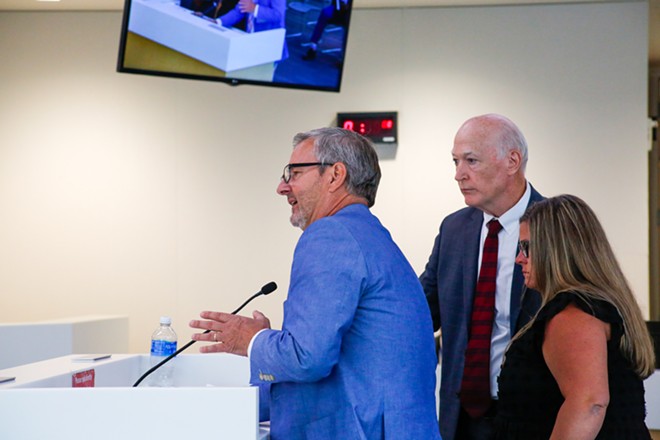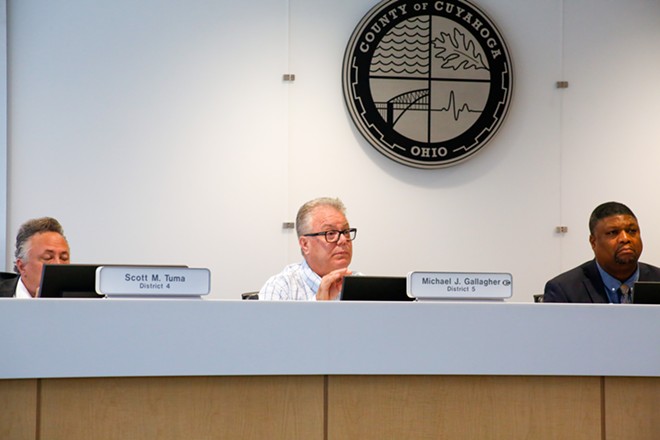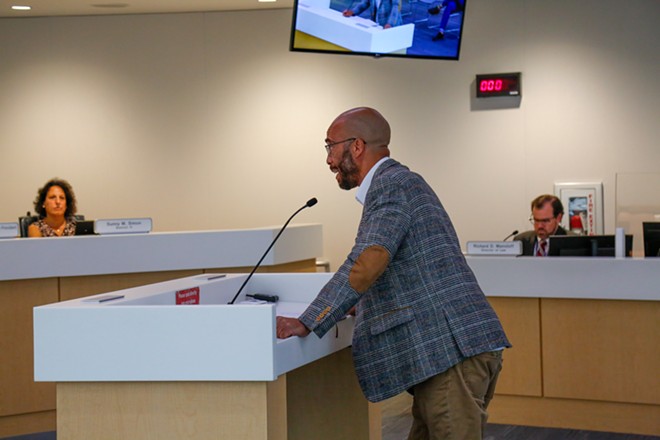
Mark Oprea
Michael Dever, Mike Chambers and Nichole English, attempted to convince County Council $750 million is enough for the build out.
County Council held its first in a series of three public meetings seeking feedback on and answers from the administration on the proposed Garfield Heights site for the new county jail this week.
On Monday afternoon, the council as a whole opened up its chambers for public comment on the site, proposed for a stretch of land in an industrial park. It was the first council-wide conversation on the site, one fully backed by County Executive Chris Ronayne, since October.
Talks about renovating the distraught County Jail, currently located in the Justice Center downtown, have been circulating in earnest for the past decade or so. Costs of fixing up the building—which lacks bed space, a hotel for visiting families, transport for sick inmates—have ranged from $130 million to today’s $500 million price tag.
A request for proposal from the County was unveiled Tuesday to gauge the cost of refurbishing or constructing another Justice Center “in the range of 800,000 square feet.” The aim would be to prepare for the inevitable relocation of the courts, while the debate of the importance of keeping them—and the jail—central looms.

Mark Oprea
Councilmembers Scott Tuma and Michael Gallagher had questioned the viability of Dever and team’s transit proposition, which would rely on a consistent plan with at least two RTA bus lines.
It’s why Michael Dever, the County’s director of Public Works, and colleague Nichole English, planning and program administrator, appeared in front of Council Monday: to convince its 11 members that they could build a 40- to 72-acre, two- or three- story site, with up to 2,400 beds total, for a solid $750 million. (What Dever calls the “guaranteed maximum price.”) And fund such steep costs via a 40-year, county-wide sales tax extension.
“We’re at the point where we’re developing the financing plan,” English told Council President Pernel Jones. “The criteria architect has been selected, they’re on board. We’ve confirmed the program. Now, we’re finalizing the site selection.”
But Council, just like the majority of the seven public commenters present, balked often at Dever and English’s certainty. Not just believing the $750 million, funded in part by $38 million in ARPA support, would survive the whims of inflation, but also trusting that the site—where I-77 and 480 intersect—could coexist with current RTA routes.
Scott Tuma, of District 4, like other members, was concerned that the proposed loop to be built adjacent to an outdoor lot, would jibe with the No. 90 route’s 30-minute intervals. Dever suggested RTA was amenable to the proposed loop design, but offered little other than a line or two in explanation.
“RTA should be heavily involved in this discussion, and planning, at least on a periphery,” Tuma told Dever. “‘Hey, this is what we’re doing. Because one of the issues that I think some of us are having is that there’s a Plan A, but no Plan B or C.”
Sunny Simon, of District 11, offered probably the most tense barrage of scrutiny for English and Dever, doubting not just the viability of the $750 million—and how to secure such money—but the credibility of their transportation plan. Dever implied that a staggered shuttle system would be used to transport detainees from the courts downtown to Garfield Heights. In sufficient time, too.
“What if the trial goes past 4:30? 5 o’clock? Middle of rush hour?” Simon questioned. “What’s the plan then?”
“True,” Dever said. “There’s no doubt something like that could happen. Those buses are going to be the main vehicle of transportation.”
For the public commenters, who ranged from current local officials to social justice advocates, the location was of paramount concern.
After all, a series of other site locations had been looked into but discarded by Ronayne and others. The Opportunity Corridor, though car-reliant, was a possibility, and liked due to its position in between Downtown and Uptown.
“What you’re being asked to consider is wasteful and it is sinful,” Kareem Henton, an organizer for the Jail Coalition, told Council in his address. “You’re proposing we spend at least three quarters of a billion dollars, which taxpayers will have to pay for 40 years.”
Like several, Henton questioned the sustainability of Dever’s proposed shuttle service, finding it needless in the end. “What’s that? More taxes? What happens when RTA does more cuts? That [line] will be some of the first to go.”
“The location best suited for transportation needs and access to services is Downtown,” Henton concluded.
Garfield Heights Mayor Matt Burke, who’s backed Ronayne’s idea since the get-go, chose rather to focus on the cleanliness and readiness of the industrial site. After all, Ronayne’s central talking point is redefining the Justice Center itself in a more humane fashion: cleaner cells, educational rehab, sites devoid of pollutants.
“What’s important to me is that the people that have to be incarcerated there and have to work there are safe,” Burke said. “And are in an environment that is not toxic.”
Council agreed, near the end of the two-and-a-half hour session, that the final negotiated price, which may or may not be $750 million, would arrive in 8 to 12 months, following confirmation of site selection.
Such promise in talk was not final enough for Simon. Before Council went to recess, Simon handed out “a few lines” of proposed legislation, asking for a contingency on the sales tax funding. So that the property, she said, “can’t be purchased without a funding source.”
Martin Sweeney, of District 3, had an issue of Simon’s spontaneous motion for a vote on a new ordinance. (Though he himself had tried the same a few weeks back.) “How long have you been working on this?”
“You’re not cross-examining me!” Simon said. “I will not answer that question.”
Sweeney turned to Jones in a fury. “Did you know this was coming today?” he said. “Can you, or will you, tell me when you knew about this?”
“Can we please have order, Council President?” Yvonne Conwell said.
Jones decided to table Simon’s proposed legislation for another session. Council will meet again for its second scrutiny of the Garfield Heights jail site in August.
Subscribe to Cleveland Scene newsletters.
Follow us: Apple News | Google News | NewsBreak | Reddit | Instagram | Facebook | Twitter | Or sign up for our RSS Feed
This post was originally published on this site be sure to check out more of their content.







